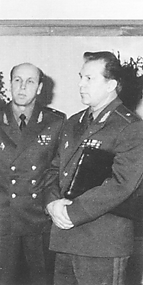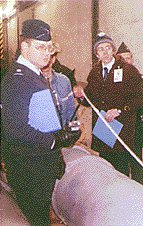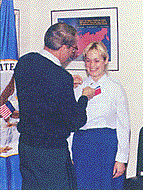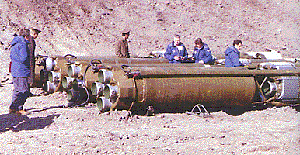| General
Major Vladimir I. Medvedev was chief of the USSR's
Nuclear Risk Reduction Center, the Soviet Union's INF
on-site inspection agency. A senior officer with
experience on the Soviet General Staff, General Medvedev
had been actively involved in treaty negotiations,
working with the Soviet group in Geneva that prepared the
final treaty documents. When General Medvedev was
interviewed by Krasnaya Zvezda, the Soviet
Ministry of Defense newspaper, he described the type of
person selected as a Soviet INF inspector and what the
job entailed: "First and foremost they are highly skilled specialists, mainly missilemen, with long service and life experiences.... They are mainly senior officers. But there are young people too--translators. . . . And the average age of the center's personnel is a little over 40.... He [the Soviet INF inspector/escort] strictly abides by the provisions of the treaty and the protocol on inspections--they lay down the rights, duties, and procedures. The inspector arrives at the point of entry into the country. . .where he is met by the U.S. officials who will accompany him. The inspector can stay, as a rule, no more than 24 hours. During that time he has to announce the site of the inspection--it is not announced in advance. Then the hosts have no more than 9 hours to get him to the requisite site. The inspection lasts for up to 24 hours. The inspector checks whether the facility has the number of weapons it is supposed to have and makes a report. It is unusual work, and there is a great deal of interest in it."21 On the last day of July 1988, General Lajoie was in Ulan-Ude with two American inspection teams. Ulan-Ude, 3,430 miles east of Moscow, was the point of entry for American teams arriving in the eastern Soviet Union. Lajoie had been a member of the first American inspection team in the Soviet Union on July 1, 1988. Now, nearly a month later, he was in this eastern Siberian city enroute to another inspection. At the airport, he discussed the status of the INF treaty with Soviet reporters: "All the initial inspections have gone very well. On our side, we have completed about 50 inspections of Soviet bases in the USSR, the GDR [East Germany] and the CSSR [Czechoslovakia]. Your inspectors have not been wasting time either. They have carried out 13 inspections in the United States and at U.S. bases in Western Europe." Lajoie complimented the Soviets on their organization and reception of U.S. inspection teams.22 Two weeks later, on August 18, Colonel Shabalin, deputy director of the NRRC center, spoke with TASS reporters about the reciprocal nature of the INF inspections. Shabalin said that the American inspection teams had conducted 108 on-site inspections of Soviet INF sites in the first six weeks. Soviet teams, he continued, had checked 26 of the 31 INF sites in Western Europe and the United States. In addition, by mid-August, he stated, the United States had four teams of on-site inspectors observing INF missile eliminations--in Saryozek, Stan'kovo, Sarny, and Lesnaya--and one group of resident inspectors conducting portal monitoring inspections in Votkinsk. This unprecedented, intense activity had produced, he believed, good working relations. Looking to the future, Colonel Shabalin concluded, "The acquired experience of the [INF] inspections proved their high effectiveness as a means of control. It could be used in the future for control over strategic offensive armaments."23 |
 Leaders of the Soviet Union's inspectorate, Colonel Shabalin and General Medvedev. |


